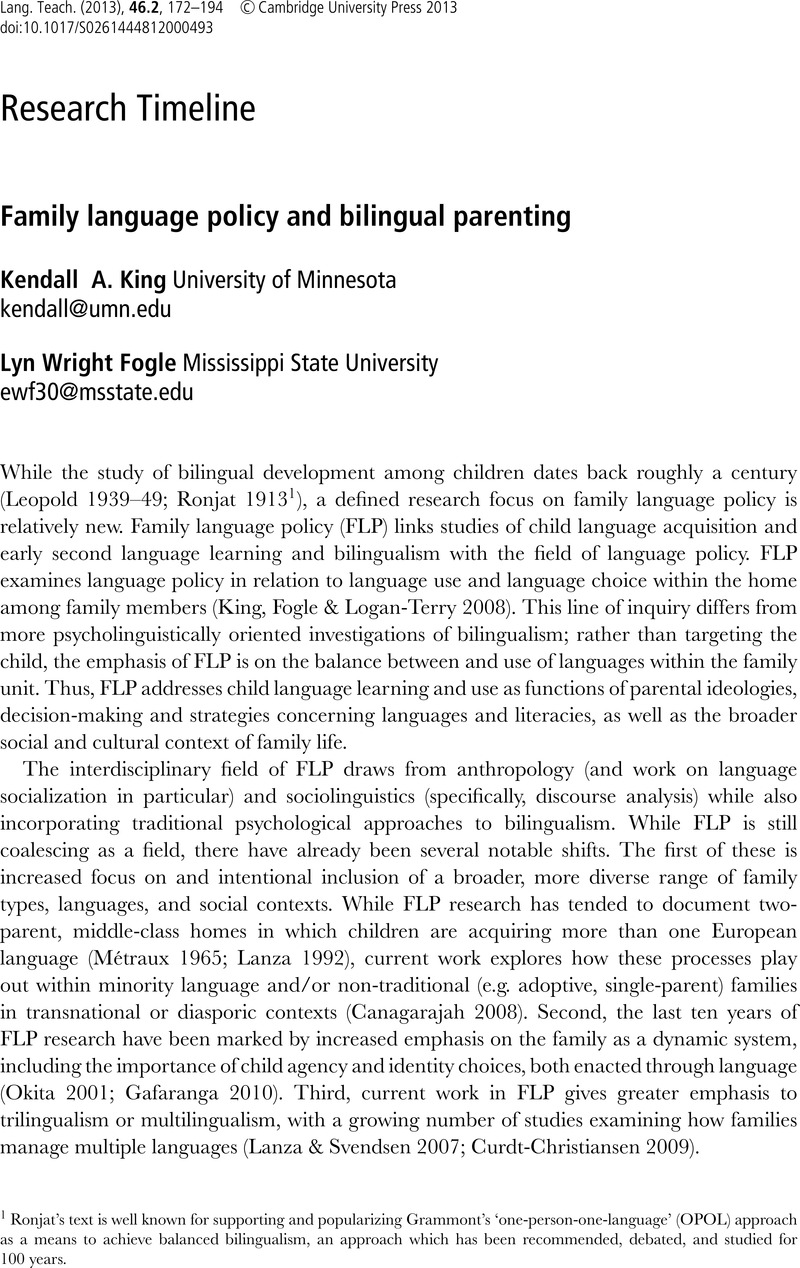Crossref Citations
This article has been cited by the following publications. This list is generated based on data provided by Crossref.
Fogle, Lyn Wright
2013.
Successful Family Language Policy.
Vol. 7,
Issue. ,
p.
177.
Curdt-Christiansen, Xiao Lan
2013.
Successful Family Language Policy.
Vol. 7,
Issue. ,
p.
277.
Shin, Sarah J.
2014.
Language Learning as Culture Keeping: Family Language Policies of Transnational Adoptive Parents.
International Multilingual Research Journal,
Vol. 8,
Issue. 3,
p.
189.
Altman, Carmit
Burstein Feldman, Zhanna
Yitzhaki, Dafna
Armon Lotem, Sharon
and
Walters, Joel
2014.
Family language policies, reported language use and proficiency in Russian – Hebrew bilingual children in Israel.
Journal of Multilingual and Multicultural Development,
Vol. 35,
Issue. 3,
p.
216.
Vincze, László
Henning-Lindblom, Anna
and
Holley, Peter
2015.
Developing internal and external motivations towards the dominant language: Some data from Finland.
Nordic Journal of Linguistics,
Vol. 38,
Issue. 3,
p.
339.
Strickland, Kait
and
Hickey, Tina M.
2016.
Using a national dataset to explore sub-groups in Irish immersion education.
Journal of Immersion and Content-Based Language Education,
Vol. 4,
Issue. 1,
p.
3.
Lanza, Elizabeth
and
Wei, Li
2016.
Multilingual encounters in transcultural families.
Journal of Multilingual and Multicultural Development,
Vol. 37,
Issue. 7,
p.
653.
Nig Uidhir, Gabrielle
Ó Cathalláin, Seán
and
Ó Duibhir, Pádraig
2016.
Tuismitheoirí ina ngníomhairí in earnáil an Ghaeloideachais.
COMHARTaighde,
Oriyama, Kaya
2016.
Community of Practice and Family Language Policy: Maintaining Heritage Japanese in Sydney—Ten Years Later.
International Multilingual Research Journal,
Vol. 10,
Issue. 4,
p.
289.
Stemper, Kathryn D.
and
King, Kendall A.
2017.
The Handbook of Linguistics.
p.
655.
Sherman, Tamah
and
Homoláč, Jiří
2017.
“The older I got, it wasn’t a problem for me anymore”: Language brokering as a managed activity and a narrated experience among young Vietnamese immigrants in the Czech Republic.
Multilingua,
Vol. 36,
Issue. 1,
p.
1.
Slavkov, Nikolay
2017.
Family language policy and school language choice: pathways to bilingualism and multilingualism in a Canadian context.
International Journal of Multilingualism,
Vol. 14,
Issue. 4,
p.
378.
Sims, Margaret
Ellis, Elizabeth M.
and
Knox, Vicki
2017.
Parental Plurilingual Capital in a Monolingual Context: Investigating Strengths to Support Young Children in Early Childhood Settings.
Early Childhood Education Journal,
Vol. 45,
Issue. 6,
p.
777.
Vincze, László
Gasiorek, Jessica
and
Dragojevic, Marko
2017.
Little chance for divergence: The role of interlocutor language constraint in online bilingual accommodation.
International Journal of Applied Linguistics,
Vol. 27,
Issue. 3,
p.
608.
Verschik, Anna
and
Doyle, Colm James
2017.
Language Policy Beyond the State.
Vol. 14,
Issue. ,
p.
123.
Liu, Lu
2018.
Language Policy and Language Acquisition Planning.
Vol. 15,
Issue. ,
p.
13.
Kheirkhah, Mina
and
Cekaite, Asta
2018.
Siblings as Language Socialization Agents in Bilingual Families.
International Multilingual Research Journal,
Vol. 12,
Issue. 4,
p.
255.
Karpava, Sviatlana
Ringblom, Natalia
and
Zabrodskaja, Anastassia
2018.
Language Ecology in Cyprus, Sweden and Estonia: Bilingual Russian-Speaking Families in Multicultural Settings.
Journal of the European Second Language Association,
Vol. 2,
Issue. 1,
p.
107.
Farr, Joanna
Blenkiron, Laura
Harris, Richard
and
Smith, Jonathan A.
2018.
“It’s My Language, My Culture, and it’s Personal!” Migrant Mothers’ Experience of Language Use and Identity Change in Their Relationship With Their Children: An Interpretative Phenomenological Analysis.
Journal of Family Issues,
Vol. 39,
Issue. 11,
p.
3029.
Kaveh, Yalda M.
2018.
Family language policy and maintenance of Persian: the stories of Iranian immigrant families in the northeast, USA.
Language Policy,
Vol. 17,
Issue. 4,
p.
443.



